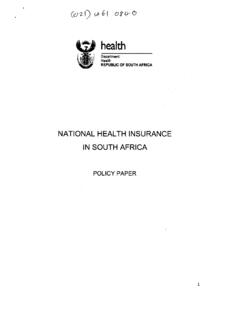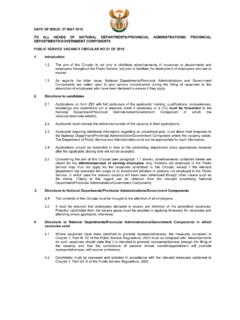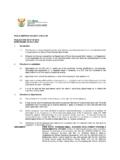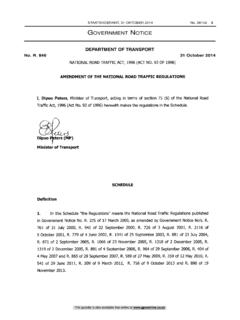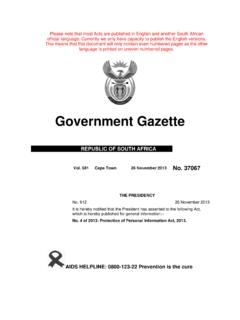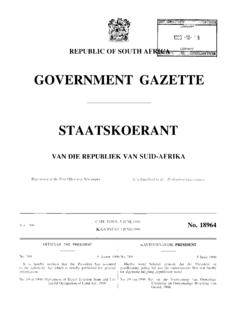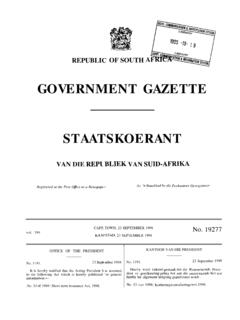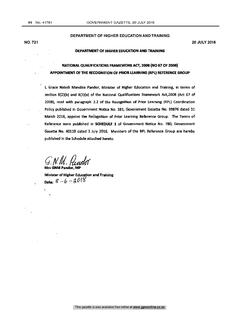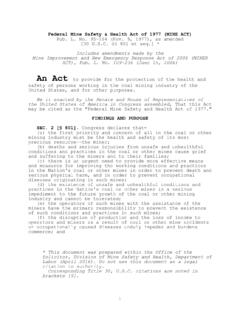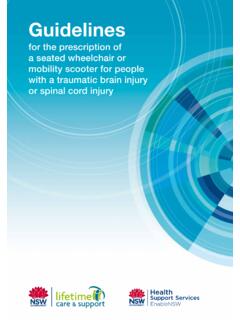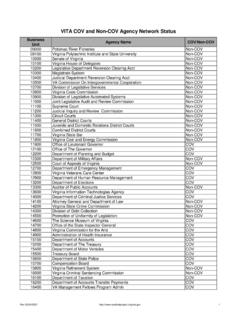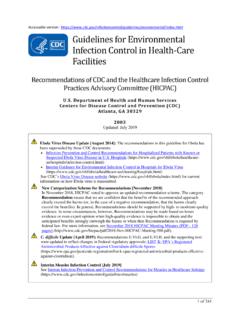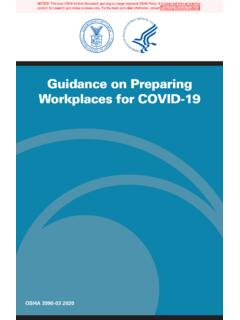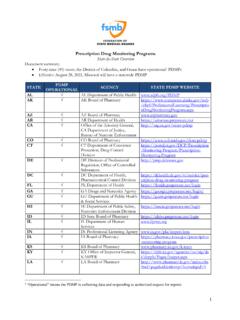Transcription of DEPARTMENT OF EMPLOYMENT AND LABOUR NO. R. 280 29 …
1 MR TW NXESI,MPMINISTER OFEMPL YMENTAND LABOURDATE: 030342/This gazette is also available free online at STAATSKOERANT, 29 MAART 2021 No. 44348 3 DEPARTMENT OF EMPLOYMENT AND LABOURNO. R. 280 29 March 2021 Government notices GoewermentskennisGewinGsGOVERNMENT NOTICE No. R.. 2021 DEPARTMENT OF EMPLOYMENT AND LABOUR occupational health AND SAFETY ACT, 1993 REGULATIONS FOR HAZARDOUS CHEMICAL AGENTS, 2021 The Minister of EMPLOYMENT and LABOUR has, under section 43 of the occupational health and Safety Act, 1993 (Act No. 85 of 1993), after consultation with the Advisory Council for occupational health and Safety, made the regulations in the Schedule. This gazette is also available free online at No.
2 44348 GOVERNMENT GAZETTE, 29 MARch 20212 SCHEDULE Arrangement of regulations 1. Definitions .. 3 2. Scope of application .. 9 3. Information, instruction and training .. 9 4. Duties of persons who may be exposed to hazardous chemical agents 11 5. Assessment of exposure .. 12 6. Air monitoring .. 13 7. Medical surveillance .. 14 8. Respirator zone .. 15 9. Records .. 16 10. Control of exposure to hazardous chemical agents .. 17 11. Personal protective equipment and facilities .. 19 12. Maintenance of control measures .. 21 13. Prohibitions .. 21 14. Classification of hazardous chemical agents .. 22 14A. Safety data sheet .. 22 14B. Labelling of hazardous chemical agents .. 25 14C. Packaging of hazardous chemical agents .. 27 14D. Disclosure of ingredient identity.
3 28 15. Disposal of hazardous chemical agents .. 30 16. Offences and penalties .. 30 17. Repeal of regulations .. 31 18. Short title and commencement .. 31 This gazette is also available free online at STAATSKOERANT, 29 MAART 2021 No. 44348 53 Definitions 1. In these regulations any word or expression to which a meaning has been assigned in the Act shall have the meaning so assigned and, unless the context otherwise indicates "air monitoring" means the monitoring of the concentrations of airborne hazardous chemical agents; "Asbestos Abatement Regulations" means the Asbestos Abatement Regulations, 2020, published as Government Notice No. of 10 November 2020 under section 43(1) of the Act; "assessment" means a programme to determine any risk from exposure to an HCA associated with the workplace in order to identify the steps needed to be taken to remove, reduce or control such HCA; "BEI" or "biological exposure index" is a value for assessing biological monitoring results, intended as a reference guideline for the likelihood of adverse health effects, and generally represents the level of determinants that are most likely to be observed in specimens collected from healthy employees who have been exposed to HCAs with inhalation exposure at the occupational exposure limit, as listed in Table 4 of Annexure 2 hereby, as revised from time to time and published in the Gazette.
4 "carcinogen" or "CARC" means any chemical agent or mixture which induces cancer or increases its incidence, classified by the GHS as (a) Category 1: known or presumed human carcinogens; or (b) Category 2: suspected human carcinogens; "CAS number" or "chemical identity" means the number or name, respectively, that uniquely identifies a chemical, given in accordance with the nomenclature systems of the International Union of Pure and Applied Chemistry or the Chemical Abstracts Service, or a technical name; "chemical agent" means a GHS-aligned chemical agent or mixture; This gazette is also available free online at No. 44348 GOVERNMENT GAZETTE, 29 MARch 20214 "chief director: provincial operations" means the provincial director as defined in regulation 1 of the General Administrative Regulations; "consumer product" means a product containing an HCA, which (a) is packed or repacked primarily for use by a household consumer or for use in an office; (b) if the product is packed or repacked primarily for use by a household consumer, is packed in the way and quantity in which it is intended to be used by a household consumer; and (c) if the product is packed or repacked primarily for use in an office, is packed in the way and quantity in which it is intended to be used for office work.
5 "container", in relation to an HCA, means anything in or by which an HCA is, or has been, wholly or partly covered, enclosed or packed, including anything necessary for the container to perform its function as a container; "cut-off value" or "GHS cut-off value" or "GHS concentration limit" means the minimum concentration of an HCA, expressed as a percentage, to trigger the classification of a mixture containing the HCA; "exposed" means exposed to an HCA whilst at the workplace and "exposure" has a corresponding meaning; "Facilities Regulations" means the Facilities Regulations, 2004, published as Government Notice No. R. 924 of 3 August 2004; "General Administrative Regulations" means the General Administrative Regulations, 2003, published as Government Notice No. R. 929 of 25 June 2003; "GHS hazard classification" means the GHS hazard classes and hazard categories assigned to HCAs; "hazard category" means a division of criteria within a hazard class in the GHS, where these hazard categories compare hazard severity within a hazard class and should not be taken as a comparison of hazard categories more generally; This gazette is also available free online at STAATSKOERANT, 29 MAART 2021 No.
6 44348 75 "hazard class" means the nature of a physical, health or environmental hazard under the GHS; "hazard pictogram" means a graphical composition, including a symbol plus other graphical elements such as a border, background pattern or colour that is intended to convey specific information, that is assigned in the GHS to a hazard class or hazard category; "hazard statement" means a statement assigned in the GHS to a hazard class or hazard category describing the nature of the hazards of an HCA including, if appropriate, the degree of hazard; "hazardous chemical agent" or "HCA" means a GHS-aligned chemical agent as provided for in Annexure 1; "HSG 173" means the Guidance Note HSG 173 of the health and Safety Executive (HSE) of the United Kingdom: Monitoring Strategies for Toxic Substances, 2006, ISBN 978 0 7176 6188 6, as revised from time to time and published in the Gazette; "importer" means an employer or self-employed person who, by any means, imports an HCA into the Republic that is to be used, or could reasonably be expected to be used, at a workplace; "Lead Regulations" means the Lead Regulations, 2001, published as Government Notice No.
7 R. 236 of 28 February 2002; "manufacturer" means an employer or self-employed person who manufactures an HCA that is to be used, or could reasonably be expected to be used, at a workplace; "measurement programme" means a programme according to the monitoring strategy as contemplated in HSG 173; "Minister" means the Minister of EMPLOYMENT and LABOUR ; "monitoring" means the planning, carrying out, and recording of the results of a measurement programme; This gazette is also available free online at No. 44348 GOVERNMENT GAZETTE, 29 MARch 20216 "OEL" or " occupational exposure limit" means a limit value set by the Minister, which represents the airborne concentration of an HCA, where the exposure standard may be (a) an eight-hour time-weighted average; (b) a ceiling limit; or (c) a short-term exposure limit; "OEL ceiling limit" or "ceiling limit" or "C" means a maximum or peak airborne concentration of an HCA determined over the shortest analytically practicable period of time, which does not exceed 15 minutes; "OEL eight-hour time-weighted average" or "TWA" means the maximum average airborne concentration of an HCA when calculated over an eight-hour working day, for a five-day working week; "OEL-ML" or " occupational exposure limit - maximum limit" means an HCA as listed in Table 2 of Annexure 2.
8 "OEL-RL" or " occupational exposure limit - restricted limit" means an HCA as listed in Table 3 of Annexure 2; "OEL-short-term exposure limit" or "STEL" means the time-weighted average maximum airborne concentration of an HCA calculated over a 15-minute period; "OESSM" means the occupational Exposure Sampling Strategy Manual, published by the National Institute for occupational Safety and health (NIOSH), Publication No. 77-173 of 1977, United States of America: DEPARTMENT of health , Education and Welfare; "permanent respirator zone" means an area where the concentration of an airborne HCA during normal operations exceeds the OEL-RL for that HCA; "precautionary statement" means a phrase prescribed by the GHS that describes recommended measures that should be taken to minimise or prevent (a) the adverse effects resulting from exposure to an HCA; or This gazette is also available free online at STAATSKOERANT, 29 MAART 2021 No.
9 44348 97 (b) the improper storage or handling of an HCA; "prohibited agent" means an HCA prohibited by the Minister and listed in Table 1 of Annexure 2, where the agents prohibited may be revised from time to time by notice in the Gazette; "respiratory protective equipment" means a device that is worn over at least the mouth and nose to prevent the inhalation of an airborne HCA and that is of a type, or conforms to a standard, approved by the Minister; "respirator zone" means an area where the concentration of an airborne HCA exceeds the recommended limit for that agent; "retailer" means an employer or self-employed person who supplies consumer products containing an HCA to members of the public who are not primarily engaged in the further supply of those products; "safety data sheet" or "SDS" means a document that is aligned to the GHS, providing information on hazard classification, properties of hazardous chemicals, procedures for handling or working with hazardous chemicals in a safe manner, and the effects of hazardous chemicals on health and safety at the workplace, and that is prepared in accordance with regulation 14A; "sensitiser" means an HCA that causes a substantial proportion of exposed people to develop an allergic reaction in normal tissue after repeated exposure, and includes dermal sensitisers and respiratory sensitisers; "signal word" means the word "danger" or "warning" used on a GHS-aligned label to indicate to the reader a potential hazard, as well as the relative severity level of such hazard.
10 "skin", the notation, means that the HCA might be absorbed in toxicologically significant amounts through direct contact with skin or mucous membranes and eyes from airborne exposure to gases, vapours or liquids, so that conclusions about exposure and health effects based solely on airborne concentration limits may be incomplete; This gazette is also available free online at No. 44348 GOVERNMENT GAZETTE, 29 MARch 20218 "supplier" means an employer or self-employed person who conducts a business or undertaking of supplying an HCA, also to a retailer; "the Act" means the occupational health and Safety Act, 1993 (Act No. 85 of 1993); "UN Globally Harmonized System" or "GHS" means the Globally Harmonized System of classification and labelling of chemicals, a guidance document developed by the United Nations for standardising and harmonising the classification and labelling of chemicals globally, as may be updated from time to time, commonly known as the UN Purple Book; "UN IMO International Maritime Dangerous Goods Code" means the International Maritime Organization's (IMO's) International Maritime Dangerous Goods (IMDG) Code, which was developed as an international code by the IMO, an agency of the United Nations, for the
